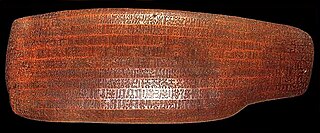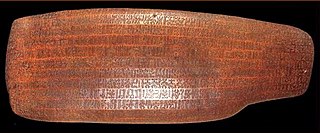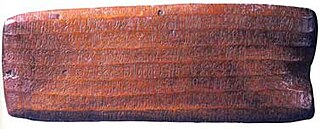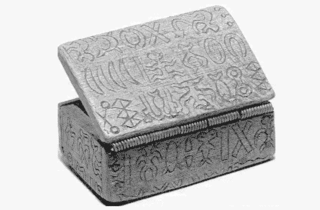
Text J of the rongorongo corpus, also known as (London) reimiro 1, is the larger of two inscribed reimiro in London and one of two dozen surviving rongorongo texts. It is also the shortest text in the corpus, being only two glyphs long.

Text J of the rongorongo corpus, also known as (London) reimiro 1, is the larger of two inscribed reimiro in London and one of two dozen surviving rongorongo texts. It is also the shortest text in the corpus, being only two glyphs long.
J is the standard designation, from Barthel (1958). Fischer (1997) refers to it as RR20.
British Museum, London. Catalog # AOA 6847.
A prototypical two-headed Rapanui reimiro, or ceremonial crescent-shaped gorget/epaulet, 73 × 13.2 cm, of unknown wood. There are a few worm trails, but it is in excellent condition. The two holes top center were used to hang it from clothing.
Two glyphs are cut into the top center of the front, between the two holes used to hang it.
The British Museum catalog states:
A label on the back reads:
Fischer says that the phrase "the master of a vessel" suggests that it was acquired before the Chilean slaving raids of 1862-63, probably during the 1820s to 1840s, the most active whaling period in the South Pacific.
Inscribed reimiro were evidently rare: An elder told Routledge that he had never seen a reimiro with glyphs.
Despite its poor provenance, there are no doubts as to its authenticity.


One compound glyph, the shortest of Barthel's 26 texts.

The second glyph is "clearly" a rapa, or ceremonial dance paddle. It appears to be held by a human figure, glyph 530 ![]() , with what might be a headdress.
, with what might be a headdress.

Rongorongo is a system of glyphs discovered in the 19th century on Easter Island that has the appearance of writing or proto-writing. Numerous attempts at decipherment have been made, but none have been successful. Although some calendrical and what might prove to be genealogical information has been identified, none of the glyphs can actually be read. If rongorongo does prove to be writing and to be an independent invention, it would be one of very few inventions of writing in human history.

Rongorongo is a system of glyphs discovered in the 19th century on Easter Island that appears to be writing or proto-writing. Text A of the rongorongo corpus, also known as Tahua, is one of two dozen surviving texts.

Rongorongo is a system of glyphs discovered in the 19th century on Easter Island that appears to be writing or proto-writing. Text B of the rongorongo corpus, also known as Aruku Kurenga, is one of two dozen surviving rongorongo texts.

Text G of the rongorongo corpus, the smaller of two tablets located in Santiago and therefore also known as the Small Santiago tablet, is one of two dozen surviving rongorongo texts. It may include a short genealogy.

Text H of the rongorongo corpus, the larger of two tablets located in Santiago and therefore also known as the Great or Large Santiago tablet, is one of two dozen surviving rongorongo texts, and one of three recording the so-called "Grand Tradition".
Text Q of the rongorongo corpus, the smaller of two tablets in St. Petersburg and therefore also known as the Small St Petersburg tablet, is one of two dozen surviving rongorongo texts, and one of three recording the so-called "Grand Tradition".
Text P of the rongorongo corpus, the larger of two tablets in St. Petersburg and therefore also known as the Great or Large St Petersburg tablet, is one of two dozen surviving rongorongo texts, and one of three recording the so-called "Grand Tradition".

Text R of the rongorongo corpus, the smaller of two tablets in Washington and therefore also known as the Small Washington tablet, is one of two dozen surviving rongorongo texts.

Text S of the rongorongo corpus, the larger of two tablets in Washington and therefore also known as the Great or Large Washington tablet, is one of two dozen surviving rongorongo texts.

Rongorongo is a system of glyphs discovered in the 19th century on Easter Island that appears to be writing or proto-writing. Text F of the rongorongo corpus, also known as the (Stephen) Chauvet tablet, is one of two dozen surviving texts.
Text K of the rongorongo corpus, also known as the (Small) London tablet, is one of two dozen surviving rongorongo texts. It nearly duplicates the recto of tablet G.

Text Y of the rongorongo corpus, known as the Paris Snuff Box, is one of two dozen surviving rongorongo texts.
Text T of the rongorongo corpus, also known as Honolulu tablet 1 or Honolulu 3629, is the only fluted tablet in the Honolulu collection and one of two dozen surviving rongorongo texts.
Text U of the rongorongo corpus, carved on a beam, also known as Honolulu tablet 2 or Honolulu 3628, is one of two dozen surviving rongorongo texts.
The fragmentary text W of the rongorongo corpus, also known as Honolulu tablet 4 or Honolulu 445, is one of two dozen surviving rongorongo texts.
Text V of the rongorongo corpus, the Honolulu oar, also known as Honolulu tablet 3 or Honolulu 3622, may be one of two dozen surviving rongorongo texts. Its authenticity has been questioned.

Text Z of the rongorongo corpus, also known as Poike, is a palimpsest inscription that may be one of two dozen surviving rongorongo texts. The authenticity of the upper text is in question.

Text L of the rongorongo corpus, also known as (London) reimiro 2, is the smaller of two inscribed reimiro in London and one of two dozen surviving rongorongo texts.
Text O of the rongorongo corpus, the Berlin tablet, is one of two dozen surviving rongorongo texts.

Text X of the rongorongo corpus, known as the (New York) Birdman, is one of two dozen surviving rongorongo texts.